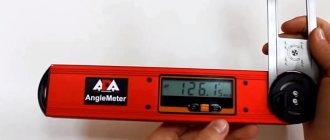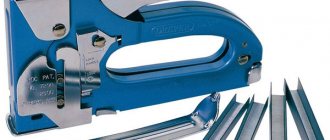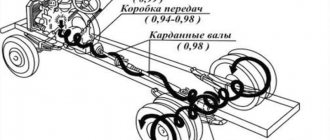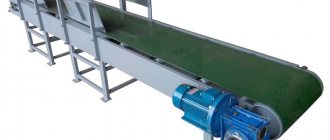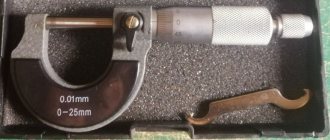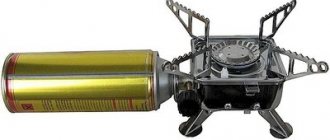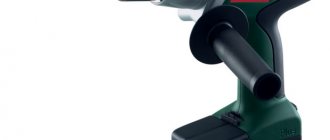History of appearance
The goniometer was invented many centuries ago. Experts say that this device was first used in Babylon and Egypt. Because the construction of huge and incredibly beautiful buildings is completely impossible without the use of a goniometric device.
Over the long period of its existence, its design has not undergone significant changes. Modern devices have almost the same appearance. The difference from ancient devices lies only in the material from which they are made. Of course, the scope of use of a modern instrument is much wider.
Electronic protractors - their application and reliability
Digital devices are popular, but not because they have high measurement accuracy, but due to the simplicity and speed of taking readings. Their main advantage is that measurements are carried out automatically and displayed. Even beginners know how to use electronic protractors, since this is the simplest type of tool. To do this, you need to attach the support bars to perpendicular surfaces, and then take the finished readings from the LCD display. Measurements are displayed taking into account tenths and hundredths of degrees, which depends on the accuracy class of the device.
The main disadvantage of electronic meters is that despite the low error values claimed by manufacturers, they are much inferior to mechanical devices.
It is only worth noting that not all devices have low accuracy, since branded models from well-known manufacturers prove their accuracy in practice. However, the cost of such devices is twice as high as conventional electronic inclinometers from China. It is rational to buy a Chinese device only if high data accuracy is not important. Otherwise, it is better to use a mechanical device with a vernier. This is interesting! In addition to the large error, digital devices have additional disadvantages, such as the need to constantly replace the battery, store in a warm and dry room, and avoid mechanical stress.
Types of goniometers and their purpose
Of the most commonly used, we note the following types of devices:
Read also: Types of collars for men's shirts
- Construction goniometer – used for marking, installation and design work. Available in different sizes and ways to measure angles.
- Carpenter's protractors - used for approximate determination of angles, often equipped with a scale with fixed angles.
- Bench protractors are used for high-precision measurements and are often equipped with a vernier scale.
- Surveyors or mountain protractors - allow you to measure even at a considerable distance.
There are also specialized goniometers, the purpose of which is quite clear from their name - astronomical, nautical and artillery.
Types of Angle Measuring Tools
The angle meter is used for a wide variety of work. The following groups of instruments are distinguished:
- The construction level has become the most widespread. The level, which is based on the change of a balloon in a liquid, has been used for many years. However, the measured indicators cannot be called accurate.
- A mechanic's mechanical angle gauge is also extremely common. In this area, templates are the most widely used, due to which the production process is accelerated.
- The optical protractor is used for landscape work. It allows you to obtain accurate data in a minimum period of time.
- In topography, a mechanical protractor protractor is used. It works well when working with cards. Its accuracy is relative.
Recently, laser systems have become widespread. They are able to measure not only angles, but also other dimensions in the shortest possible time. In this case, the error can be only a few hundredths of a millimeter or less.
Other protractors
Of course, goniometric techniques are not limited to those listed above. In fact, this class of measuring instrument has an ancient history. Phoenician sailors also used sextants, the oldest goniometer instruments. In addition to sextants, sailors also use such a device as a nautical octant; as a measuring scale, it has a scale that covers only 45 degrees. But this is enough to observe the stars and thereby determine your location in space. Using a vernier scale allows for more accurate calculations.
Goniometer sextant instrument
Goniometer tool octant
When carrying out construction work, a protractor inclinometer is widely used. It is used to measure the location of building structures in space and relative to each other. When making furniture work, it is also important to maintain certain angles, for example, between the walls of a cabinet or bedside table.
How does a pendulum protractor work?
Structurally, the device resembles an analog clock, as it is presented in the form of a round dial with markings applied in 1-degree increments. The peculiarity of the instrument is that the arrow on the dial always has a strictly vertical position, and works on the principle of a pendulum. The device has two scales graduated in degrees, red and black.
- The red scale determines values if vertical surfaces are measured
- The black scale calculates readings when measuring a horizontal surface
Now let's figure out how to use a pendulum inclinometer correctly. To do this you need to do the following:
- Place the tool on the plane to be measured using a special support base.
- Press the locking ring of the device, which is located in the upper part
- Wait until the needle stops oscillating and then release the locking ring.
- The arrow will remain at the corresponding value, and now you can read the degrees, which will not cause any difficulties. The main thing is not to confuse when to shoot on the red and black scale of a pendulum goniometer
The main feature of the device is that it allows you to measure the angle of a surface without using an additional plane, as is typical for mechanical devices. The disadvantage of a pendulum protractor is its tendency to mechanical damage. To eliminate such consequences, you need to use the device carefully and store it in a special case.
How to make malka at home?
Of course, today all the necessary tools, in our case a small tool, can be bought at a hardware store. But sometimes situations arise when a device is needed now, and there is no time for it, or the necessary tool is simply not available for sale. Let's try to figure out how to make malka with your own hands from available materials. And here is what materials we need for these purposes:
- Wooden beam measuring 20 by 30 mm. We will make a block from it.
- Plywood with a thickness of 3 to 5 mm, it will be the moving part of the tool, the pen.
- Fastening element in the form of a nut and bolt.
- Electric drill and drill bit that matches the diameter of the fastener.
Article on the topic: What types of depth gauges are there? (+ 5 videos)
Having prepared all the components of the future instrument, you can begin assembling it. First of all, let's start making the pads. We measure 10 centimeters from the wooden block, more is possible, but you should not exceed the length of 15 centimeters. Use a hacksaw to cut the desired size of the future block. The next step in making the tool will be making a slot for the pen. To do this, make a cut on one side of the end base of the block, and for now put the block aside.
Now let's move on to making a feather, which can be cut from plywood or other suitable material. Let us mark on the plywood the future dimensions of the element, the width of the feather is 20-30 mm, the length can reach 300-400 mm. Advice! All dimensions given in this example can be changed at your own discretion. In the process of making a small tool, you can increase the length of the block and feather, the main thing is that it is convenient for you to work with the tool you have made. The feather is ready, and now it can be more accurately adjusted in the block.
Check the cut at the end of the block again; the feather should form an acute angle when you try to fold the tool, although, of course, this is not necessary in all cases. When everything is ready, you need to install the fasteners in place; to do this, align the parts at an angle of 90 degrees and drill a hole through with a drill. Then insert the bolt and clamp the parts together with a nut. Theoretically, our tool is ready, all that remains is to modify the pen a little. Move it in the block, and further process the protruding corners. The excess should be removed and the cut areas treated with sandpaper.
Mechanical protractor and features of its application
The mechanical type goniometer is classified into three types - simple, with a protractor and with a vernier. The simplest mechanical goniometer (malk) is designed for template angle measurement. What does this mean? It cannot be used to find out the angle in degrees, since it does not have a built-in protractor. The measured angle is transferred to the template and then used to make similar parts. As mentioned, the device is not highly accurate, but it is sufficient for carpentry work. Such a tool is also used in construction, for example, when installing slopes.
Now consider a model of a protractor with a protractor (it is called a quadrant), which allows you to find out the degrees of the measured angle with a slight error. Such a tool is made of steel or plastic, and consists of two adjacent bases in the form of slats, as well as a protractor and an index bar.
Using a quadrant goniometer is quite simple, and its error of 1-2 degrees allows it to be used in construction, for example, when covering roofs. The meter allows you to measure angles from 1 to 180 degrees.
Not many craftsmen know how to use a mechanical protractor with a vernier. The vernier scale of the device is needed in order to obtain high measurement accuracy. A device with a vernier is also called universal, since it can be used in different areas.
Universal goniometer with vernier design
The accuracy class of a mechanical device is very high, and if you compare the readings of a mechanical and electronic one, the first option will show more accurate results despite its age.
This is interesting! If you need to measure the exact angle of two perpendicular planes, it is recommended to use a protractor with a vernier scale.
Using the tool is quite simple. For this purpose, the device has two scales - in degrees (protractor) and vernier. The vernier division price is 2 degrees. It can be used to measure up to 320 degrees. The principle of measurement is that the whole number in degrees is read on the protractor scale, and the fractions on the vernier.
To do this, you need to find exactly matching marks on two scales and take the readings. Devices with vernier are produced according to GOST 5378-88 standard. More details on how to use the vernier scale are described in the material “How to use a vernier caliper.” The video shows the design and features of using a mechanical protractor with a vernier.
Opinion about Intertool MT-2050 models
This protractor (universal) is used primarily in the mining field. It is also in demand among engineers. The base of the model is small in width. There is only one lock in the device. There are two scales on the vernier. According to customers, the base rarely breaks. In this case, a bubble level is not provided.
The device is not clearly suitable for topography
First of all, it is important to note the heavy weight of the base. Buyers also talk about the short length of the auxiliary ruler
If we talk about parameters, then the measurement accuracy is 0.2%. The battery in this case is used at 3 V. The main ruler is designed for 35 cm. You can buy this protractor (universal) in the store for 4 thousand rubles.
Scope of use
The scope of application of goniometers is practically all areas of human activity. They are required wherever the design of products, the construction of their drawings and the marking of workpieces are carried out. Angular measurements are carried out in such industries as:
- construction;
- industry (from mining to clothing);
- warfare;
- education;
- transport;
- basic science;
- applied research;
- art;
- education.
An inclinometer is used in various fields, including in construction.
Angles surround a person everywhere; he uses inclinometers everywhere.
Characteristics of inclinometers
By definition, an inclinometer is a device designed to construct a plane parallel to the horizon. If the device has additional elements, it can be used to determine vertical lines, in accordance with the readings of a plumb line, or specified inclination angles. This device is otherwise called a level and is divided according to its design type into:
- bubbly;
- optical;
- aquatic;
- laser
It is noteworthy that to increase functionality, some instruments use elements that characterize two types of inclinometer. An example is a bubble level equipped with a laser pointer (or two), which allows you to mark a given point (or line) instantly and at a considerable distance.
The equipment of individual inclinometers includes several measuring instruments at once, which makes it possible to increase their functional characteristics. Such devices are used to make complex calculations with several input parameters. They find their application in the construction of structures of complex geometric configurations.
Choosing a protractor or what you need to know before buying
Based on the above description, you can make an appropriate decision about which type of tool is preferable to buy. Often the choice falls on mechanical or digital devices, followed by laser ones, and pendulum and optical devices are the least popular among home craftsmen. To choose the right meter, you need to consider the following criteria:
- The material of manufacture can be plastic, aluminum or steel. You should choose aluminum devices as a last resort, since they have a short service life
- The quality of the scale and the performance of the instrument as a whole - we visually determine how high quality this device is. If it was assembled not at the factory, but in a basement in a hurry, then this will be clearly visible. You should not choose such models
- Price - a good device will cost accordingly. If it is a mechanical instrument made of plastic, then you can buy it for 500-600 rubles; with a vernier, devices made of steel cost at least 1,500 rubles, and the most expensive ones are electronic and laser meters
To summarize, it should be noted that the type of measuring instrument in question should be in the arsenal of every master. With its help, you can not only measure the angle between two perpendicular surfaces or a specific part, but also produce high-precision workpieces and mechanisms.
Tool equipped with a vernier
This is one of the most popular and convenient varieties. Vernier is an additional scale installed on the instrument. This compact element is fixed at the top of the base and remains stationary during operation. It is designed to accurately determine divisions on the main scale.
The meaning of the vernier operation is based on the fact that human vision with its use determines the coincidence of individual divisions much more accurately. Protractors that are equipped with this simple device are much more practical to use than conventional ones. In addition, the measurement process itself with a protractor with a vernier will be much better.
Design features and operating principle
The geometric principle of operation of any goniometer device is based on comparing the value of the measured angle with part of the circumference. A full circle corresponds to an angle of 360 degrees; the unit of measurement for an angle is defined by scientists as 1/360 of a full circle - 1 degree (angular). With increasing accuracy of measurements, they began to talk about fractional parts of a degree - decimal fractions or 1/60 of its part - an arc minute and 1/360 - an arc second.
The simplest mechanical protractors consist of a semicircular scale measured in degrees and a movable ruler fixed at one end. The measurement is carried out as follows:
- one side of the angle being measured is aligned with the base of the scale;
- the other with a movable ruler;
- At the intersection of the ruler and scale, the angle value is read.
More advanced models are supplemented with units that make it easier to read scale readings, fix the position of the device relative to the horizon, allow you to fix the direction to distant points on the sides of corners, and others.
What is a mechanical angle meter?
The most affordable option is mechanical inclinometers. They allow you to obtain accurate data, but are characterized by less accuracy. When choosing a protractor, attention is paid to the following points:
- What regulatory document was used as standards during production?
- What is the accuracy of the angle measuring tool.
- Features of device operation.
There are various versions of mechanical measuring instruments on sale; construction protractors have become widespread. The vernier type is represented by the following design:
- Frame.
- Disc fixed to a nut.
- Base with scale and vernier.
- Ruler and shank.
Vernier protractor
Vernier type protractor device
Optical versions are characterized by a more complex design. A separate group includes mechanisms that are in fact templates.
Information about measurement methods
The following methods are used to measure angles:
- By comparison with reference samples.
- The goniometric method, which is based on the use of measuring devices with a goniometric scale.
- The trigonometric method consists in determining parameters that are rigidly related to the angle using a trigonometric method.
Methods of measuring with a goniometer tool
The size of an angle, in absolute units, is measured using a measuring tool called a goniometer. This term has many analogues - protractor, goniometer, sextant, astrolabe, etc. These instruments are distinguished by the accuracy of the measurements they perform; they may have different devices, but the principles of measurement are the same. Vernier protractors are most often used in practice.
Protractor design
This device is classified as a mechanical type measuring instrument. Their main task is to measure geometric angles in parts and structures.
Design of a universal goniometer
A goniometer with a vernier refers to a mechanical type of measuring instrument that is used to measure geometric angles in various parts and structures. The measurement results are presented in degrees; the presence of an additional scale makes it possible to obtain more accurate results. This additional scale is called vernier. It is fixed on an elongated ruler. Thanks to the use of this scale, measurement accuracy can be obtained within tenths of a degree.
One of the most common inclinometers is the 4UM model. With it you can take measurements in the range from 0 to 180 degrees. This measuring device meets the requirements of GOST 5378-88. The main area of its application is the industry associated with the production of parts and metal structures. In addition, it is used in repair production.
The main advantage of this device is its accuracy. Its use allows one to operate with fairly accurate figures, and this is what has ensured its demand among specialists in various industries. Like most mechanical measuring instruments, the goniometer instrument has a long service life; it does not have a specific shelf life, of course, subject to full compliance with the rules of operation and storage.
The disadvantages of this class of devices include difficulty in repair. There are no parts in this product that can be simply replaced; they are difficult to manufacture and most often have to be ordered from the manufacturer.
By the way, instruments for carrying out mechanical measurements are often compared with electronic ones, and although they look quite outdated, they are still in service.
How to use a vernier protractor
How to use a vernier protractor? Mechanical type goniometer equipment is quite simple. It can be used on any surface and can measure both external and internal angles. When installing the device, distortions must not be allowed; this can lead to a significant error.
The device is equipped with a special scale, which allows you to increase the accuracy of measurements by an order of magnitude. In some ways they are similar to a traditional caliper. For example, to measure an external angle, it is enough to attach a ruler located at the base of the device to one of the planes, and bring the moving part connected to the scale to the other. As a result, it will be possible to find out the desired angle. For more detailed information, see the operating instructions for the angle measuring device. It, like the passport, is included in the delivery package.
The basic scale shows degrees; in appearance it looks like a school protractor, and measuring angles with a protractor with a vernier is not difficult even for a beginner.
Verification
All measuring instruments used in production must undergo a mandatory verification procedure. At least at those enterprises where a management management system has been implemented.
Verification of a measuring instrument is a set of certain operations, the result of which is the conclusion of the authorized body on the compliance of the presented instrument with the stated requirements.
Verification with a protractor with a vernier should be performed only in laboratories that have been certified by Rosstandart of the Russian Federation.
The verification period is set by the metrology department of the enterprise.
Types of goniometers based on measurement principle
Depending on the method of angular measurements used, devices are divided into several types:
Mechanical
Mechanical protractors, widely used in plumbing and carpentry, are divided into two subtypes:
- simple, representing an angular scale-protractor and a ruler fixed at one end at the origin;
- equipped with a vernier - an additional scale for more accurate reading.
Mechanical goniometer
Measurements of flat angles are carried out using the contact method - the tool should be pressed tightly to the surface.
Pendulum
In addition to determining the angle between two directions, it is also possible to make angular measurements relative to the horizon. In ancient designs, a plumb line, a rectangle, or a gimbal were used for this; in modern ones, a design is used that stabilizes its position in space due to the rapid rotation of a rotor-gyroscope. The device allows you to quickly determine the slope of a surface, the slopes of the sides of complex structures, etc. Some laser rangefinders can determine the position of the horizon line by processing GPS satellite signals
Optical
In this type of device, one (or both) sides of an angle are marked using an optical system aimed at a marker point on the object being measured. This is a remote sensing tool. These include navigation, mining, astronomical and many construction instruments.
Laser
These are the most advanced devices to date. Usually they are combined with a laser rangefinder, angular measurements are an additional function of most of them. Two or more laser beams are directed at points lying on the sides of the angle being measured. The processor calculates the angular values and displays them on the device display. It can measure angles in any plane and count them from a user-specified coordinate system.
The simplest devices use a mechanical scale on which the operator turns a dial with a laser pointer installed. Advanced ones process the reflected laser signal independently.
Laser protractor
Widely used for marking construction sites and industrial structures. If the illumination spot from the laser beam is difficult to see in bright sunlight, additional amplifiers and reflectors are used.
Electronic
The values are calculated by the built-in processor. The measurement results are displayed. The devices allow you to remember the results of the latest measurements and carry out calculations based on them: for example, the difference between two measured angles. Such devices are actively used when marking workpieces in mechanical engineering and woodworking industries, and when cutting sheet and roll materials.
In addition, in study, production, construction and in everyday life, constant angle goniometers are widely used - these are templates made with a fixed angle of 90, 30, 45, 60. With their help, you can determine whether the measured angle is equal or not to the value fixed in the template.
Types by industry
Angle measurement is required in a variety of industries - construction, carpentry and joinery, mining and geodetic work, navigation. With the introduction of computer technology in complex industries and military equipment, protractors have been replaced by complex built-in devices. Their operating principle is similar; the manual device is used only when necessary.
Building
The most common type of protractor.
It consists of two docked rulers from 30 to 100 cm in length, between which there is a mechanical or electronic scale.
Suitable for measuring the angle between:
- rafters;
- walls;
- vertical and horizontal building structures.
It has high accuracy, the error can be no more than 1 degree. For professional work, the tool must be ergonomic and weigh no more than 1.5 kg.
Locksmith
Compact device for precise measurement and variable adjustment. Allows you to measure parts that will then be used in rotary mechanisms. Deviations in degrees are minimal; when interacting with such a protractor, skill is required.
Plotnitsky
It consists of two guide rulers connected to each other by a rotating mechanism with division.
Used in woodworking to measure the angle between structural elements.
Measurements are not always accurate; the device may have play between the adjustment mechanisms. The cost of carpentry protractors is lower than others; such a tool is often used for household needs.
Mountain
The design of the device has a scale with degrees, as well as an optical device for adjustment. Used to measure vertical and horizontal angles in space, for example, in mines or mine workings. It has an error in operation; a mountain goniometer is rarely used in practice due to the availability of high-precision equipment for this purpose.
Astronomical
A complex device consisting of several scales and optical elements.
Variable in settings, has high measurement accuracy.
Allows you to estimate the angle between the earth's surface and specific points in the sky.
It is used to calculate the trajectory of celestial bodies, their size and speed of movement. Almost all mechanical telescopes have a built-in protractor, which allows you to study distant objects in the sky.
Nautical or navigational
Due to the active development of satellite technologies, in practice it is used only in emergency situations, for example, in the event of an electronics failure on a ship. It looks like a triangular design with a floating mechanism for adjustment and adjustment. This type of goniometer is designed to determine the geographic latitude and longitude of a specific point. The work requires the presence of special tables, since the principle of operation is the knowledge that the celestial body at a certain time is above the horizon at a specific angle.
Artillery
Installed on military equipment, such as artillery cannons, to adjust the accuracy of multiple rocket launchers. Allows you to determine the direction and range of a shot with an accuracy of several meters. Initially, only a mechanical scale was used; in modern instruments it has been replaced by an electronic or optical design.
Main types of goniometers
There are many types of this device. As a rule, they differ in purpose. The following models are on sale today:
- For installation and construction work. Devices of this type are used primarily for marking. A construction mechanical goniometer is also used in the process of developing design drawings.
- Carpentry. These devices are used to work with wood blanks.
- Mountain. Used for surveying surveys.
- Seaworthy. Used to identify geographic latitude.
- Mechanic's tools are used for specialized work. This device is characterized by a high level of measurement accuracy.
- Educational (school). These rulers and protractors are used in schools and universities.
- Artillery squares have the highest accuracy. Such devices are used in the installation and adjustment of artillery pieces.
- A universal tool that can be used for different jobs.
Modern devices may also vary in accuracy and size. In addition, devices can be designed to measure internal or external angles.
Malki "Bison"
Thus, both brands described above, which have a classic design, are rated by consumers as quite worthy. However, sometimes this type of tool is necessary to perform the simplest jobs. In this case, a special type of protractor is usually used - small ones. Their main distinguishing feature is the simplicity of their design.
To perform such work as measuring the corners of an apartment when installing skirting boards, for example, mechanical protractors “Zubr”, which are quite popular among consumers, are often used. They consist of only two elements - a metal strip and a ruler with a scale movably attached to it.
Application
As already noted, goniometer devices have found their application in almost all sectors, industry, and transport.
In the construction industry, goniometers are used when performing installation work, marking and design work. With its help, they control the installation of building structures that are located at a certain angle relative to each other. Moreover, measurements can be carried out in three planes. In addition to the goniometer, plumb lines and levels are used in construction.
In addition, goniometric tools are used in carpentry, carpentry, and geodesy. Even in medicine, this instrument is used to control joints, spine, etc.
